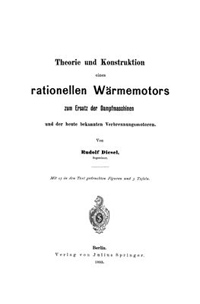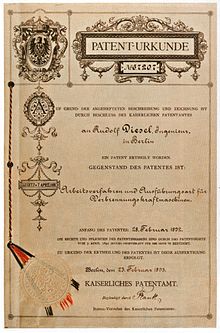 First edition | |
| Author | Rudolf Diesel |
|---|---|
| Original title | Theorie und Konstruktion eines rationellen Wärmemotors zum Ersatz der Dampfmaschine und der heute bekannten Verbrennungsmotoren |
| Language | German |
| Genre | Scientific literature |
| Publisher | Verlag von Julius Springer |
Publication date | 10 January 1893 |
| Publication place | German Realm |
Published in English | 1894 |
| Media type | |
| ISBN | 978-3-642-64949-3 |


Theory and Construction of a Rational Heat Motor (German: Theorie und Konstruktion eines rationellen Wärmemotors zum Ersatz der Dampfmaschine und der heute bekannten Verbrennungsmotoren; English: Theory and construction of a rational heat motor with the purpose of replacing the steam engine and the internal combustion engines known today) is an essay written by German engineer Rudolf Diesel. It was composed in 1892, and first published by Springer in 1893. A translation into English followed in 1894. One thousand copies of the German first edition were printed.[1] In this essay, Rudolf Diesel describes his idea of an internal combustion engine based on the Carnot cycle, transforming heat energy into kinetic energy using high pressure, with a thermal efficiency of up to 73%, outperforming any steam engine of the time.[2]
Diesel sent copies of his essay to famous German engineers and university professors for spreading and promoting his idea. He received plenty of negative feedback; many considered letting Diesel's heat engine become reality unfeasible, because of the high pressures of 200–300 atm (20.3–30.4 MPa) occurring, which they thought machines of the time could not withstand.[3] Only few found the actual mistake in Diesel's theory: Isothermal-adiabatic compression, which the theory is based on, is impossible. Even with almost isothermal-adiabatic compression, an engine could not operate because of the lean air-fuel mixture.[4] In other words, an engine as described in the essay would require so much compression work that it could not perform any useful work.[5][6]
Yet, some scientists of the time praised Diesel's idea, which would lead into Maschinenfabrik Augsburg and Krupp Essen forming a consortium for building Diesel's engine. Diesel, who was then ordered to build his own engine, realised his mistake and considered using a modified combustion process. Key changes are the way of compression, which is only adiabatic in the modified combustion process, the pressure, which Diesel reduced significantly,[7] and the fuel injection, where Diesel increased the fuel quantity. In 1897, after four years of work, Diesel had successfully finished his rational heat motor using his modified combustion process. This engine became known as the Diesel engine. Publicly, Diesel never admitted that he had to use a different combustion process from that one he described in his essay, because this would have rendered his heat motor patent obsolete.
- ^ Cite error: The named reference
S68was invoked but never defined (see the help page). - ^ Cite error: The named reference
D51was invoked but never defined (see the help page). - ^ Cite error: The named reference
S72was invoked but never defined (see the help page). - ^ Cite error: The named reference
S74was invoked but never defined (see the help page). - ^ Cite error: The named reference
S71was invoked but never defined (see the help page). - ^ Cite error: The named reference
Sass399was invoked but never defined (see the help page). - ^ Cite error: The named reference
S75was invoked but never defined (see the help page).